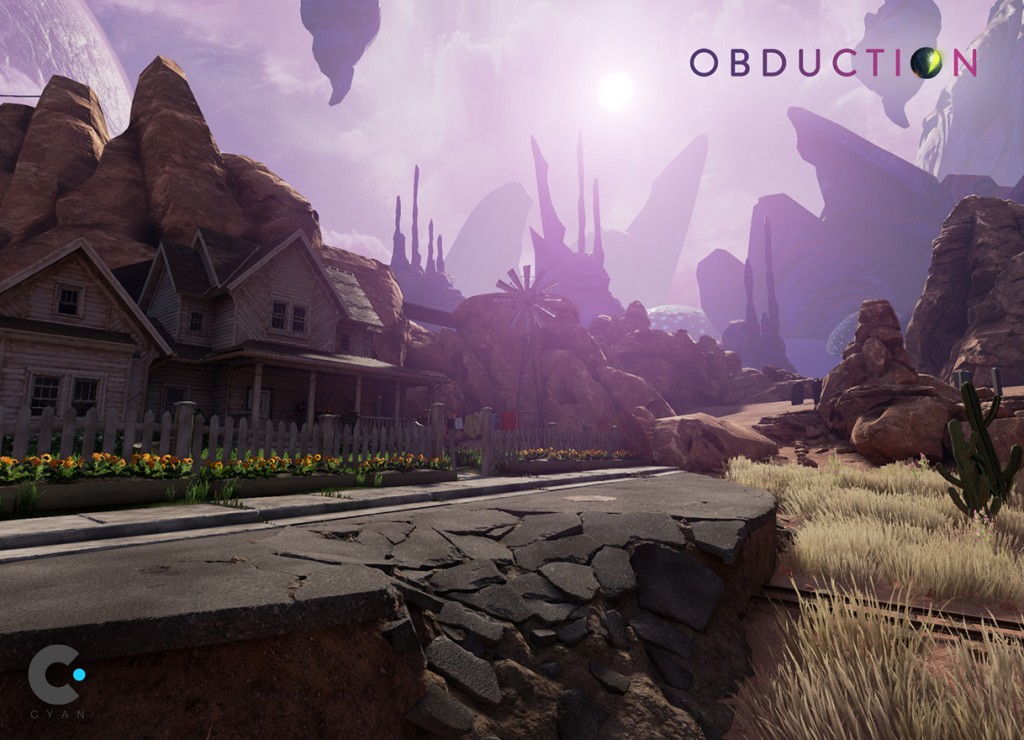[cn: This review is spoiler-free. I can’t speak for the comments.]
Obduction is a new game by the team that brought us Myst. Having played all the Myst games when I was younger,* I ended up buying Obduction, and almost immediately regretted it.
Hear me out, it’s not that it’s a bad game. It just reminded me of why I think retro pixelated games are so popular these days. Game creators can advertise high-quality graphics all they want, but ultimately the hardware required to render these graphics is sold separately. In many ways, this game had uglier graphics than Myst IV. I had to put the graphics on the lowest settings, deal with terrible frame rates, and sit through lots of long loading screens. My advice: bring a book.
That aside (and also putting aside numerous other technical issues), Obduction is an okay game. The main attraction is the story. Just sharing a bit of the game’s introduction: you find yourself teleported to a strange world, a deserted mining town surrounded by an alien landscape. You have to use environmental clues to figure out both the mechanics of the sci-fi world, as well as the events leading up to the desertion. But it’s not all mystery and sci-fi, it’s also about the human angle.

Image credit: Cyan
The second aspect of the game are the puzzles. I joke about how the puzzles of the original Myst games were all about navigating obtuse user interfaces. I think that is not quite true here. Obduction is all about navigating obtuse map layouts. You hit a switch and it changes something over there–now how do you get back there again? Sprinkle in a bunch of weird teleportation mechanics and elevators to make it more confusing. Also, the player character seems to have a mobility impairment that prevents them from climbing mildly uneven rocks.**
I like the concept of building mental maps as a major puzzle element, but it never got very challenging. I can’t shake the feeling they weren’t really trying to make the map into a puzzle, and were just bad at designing navigable spaces. There are also some “explicit” puzzles in the game but I found them to be fairly obvious and repetitive. This is too bad–Myst-type puzzles are supposed to be expensive to create, but never repetitive. They somehow attained the worst of both worlds.
In my opinion, the best puzzle in the game was figuring out the story. It was reading a few journals, looking at the environment, making inferences, and then understanding. I know we wouldn’t usually think of that as a puzzle, and certainly you’re not required to solve it in order to complete the game. But that bit of sleuthing is quite satisfying.
*In my humble opinion, here is the Myst series from best to worst: 4 > 2 > 1 > 3 > 5 >> Uru. Obduction is probably between 3 and 5.
**Come to think of it, how cool would it be if the player character canonically had a mobility impairment? It could be a game about the frustrations of navigating a space not designed for you. This would be a good justification for the obtuse map layout.

Oh god yes those maps. I haven’t played the game myself but I’ve been watching my roommate play a lot as an occasionally helpful backseat driver, and I gave up on trying to memorize how to get around the maps pretty quickly. I think the maps and teleportation were a neat feature and actually a lot of fun during the first initial round of exploration, but after a while we were spending most of our game play time just walking back and forth down convoluted paths to get to different areas and that started to get old fast, especially when we knew the paths better and it was just a slow slog instead of any kind of critical thinking puzzle.
As for the graphics, I thoughts some of them were kinda pretty but they did get repetitive, and even on a pretty decent rig we could barely get to medium quality before everything lagged to hell.
Are you kidding? There’s no way retcon-ruined Revelation beats Riven. Switch those two around or incur Fanboi Wrath® and spend eternity locked in a prison book (not a prison age, those aren’t real).
@Jake,
Atrus totally rewrote the prison books to be prison ages. The game was a political statement about the value of rehabilitation over punishment. … or something.
By contrast, the retconning in Myst V & Uru was unacceptable. You can bring the linking books with you? What nonsense!
@Siggy:
He burned both prison books at the end of Myst, and then tried to forget everything. When Saavedro ransacked his house at Tomahna, he found no references to Sirrus or Achenar. There is no way he was secretly holding onto those books waiting for the chance to transform them.
Actually, I think the moral of Revelation was “bad guys who spend 20 years chilling with mangrees are actually good-hearted inside, while bad guys who spend 20 years imprisoned in a foreboding chunk of rock full of mad science gear are clearly irredeemable.”
I’ve never played either.
That’s my story and I’m sticking to it.